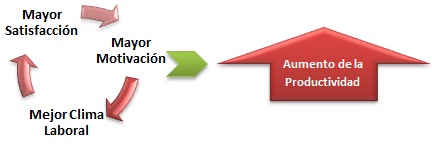Although difficulty has always generated the direct association of social and human aspect against the numerical results of the organization, establishing indicators on prospects for social learning and to identify more and more clearly the positive correlation between productivity with good organizational climate.
To reach this statement is necessary from the very definition of organizational climate understood as ‘the quality or property of the organizational environment that a) perceived or experienced members of the organization b) influences their behavior’.[1]

To this respect, a good labor climate demonstrates a perception of satisfaction of the employee it was doing the environment and content of his work, he finds it motivante and leads it to straining for having good results. On the contrary, if there is no a good environment inconformity and disinterest is demonstrated by the work and a low performance in the same one. It is a bidirectional relation.
The benefit of measuring the climate for the organization is that it allows you to identify the level of favorable or unfavorable perceptions their employees from the different contextual factors and job content. This way you can identify specific improvement actions that generate greater motivation for the employee and thus greater productivity.
There are several ways for measuring climate:
- Questionnaires
- interviews
- Observation
- Group Dynamics
- Debates
Most used they are questionnaires and interviews, nevertheless, beyond the methodology to using, to the moment to realize the measurement 10 key aspects must be born in mind:
- To define variables to evaluating and the population participant (total or a sample of the employees).
- To sensitize the whole organization opposite to the process, principally if it is the first time.
- To apply a methodology within reach of all the levels of the organization.
- To involve the leaders of the high direction and those of equipments in the process.
- Creating an atmosphere of trust in the process.
- The results share opportunely once finished the process.
- To identify areas of strength and improvement.
- To involve leaders and teams in generating action plans.
- To establish priorities for the short and medium term actions.
- To inform all of the actions to continue and show the obtained results.
In conclusion, the diagnosis of work environment helps the organization to identify the factors that are positively or negatively affecting satisfaction and employee motivation. Finding the critical areas you can set specific improvement actions and thereby promote from managing its human resources increased productivity and achieving organizational results.

[1] George H. Litwin, “Climate and Motivation: An Experimental Study” en David A. Kolb, Irwin M. Rubin, James M. McIntyre, Organizational Psychology: A Book of Readings, Englewood Cliffs, Prentice-Hall, 1971.
Olga L. Salazar P.
osalazar@strategos.com.co





Leave a Reply